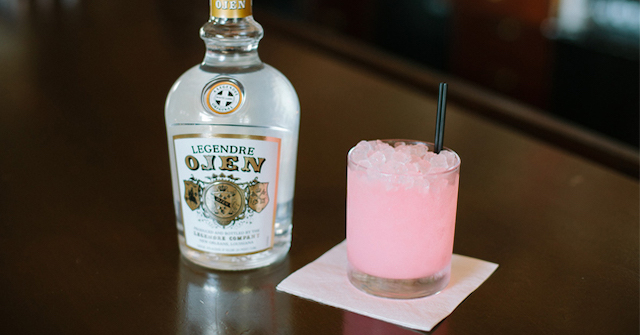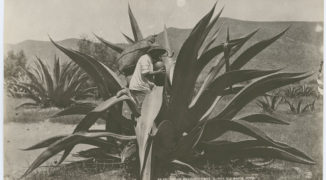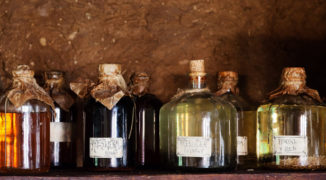Mardi Gras is upon us. This year, it comes with the return of a legend. History is in the bottle and on the label: Legendre Ojen.
Kevin Richards, marketing director for whiskies and specialty brands at Sazerac, oversees all of the company’s NOLA-centered brands, and he’s a man who knows his city and the history that feeds it. According to Richards, Ojen bears the name of a small town in Andalucia. “The story goes that there was a family [Morales, a family of distillers] . . . They started this spirit called Ojen.” They distilled the spirit until the end of the nineteenth century. Then the recipe was buried — all but literally.
“One of the Morales male heirs took the family recipe to the grave,” Richards says. That ended Ojen production in Spain.
“In the 1930s, 1940s,” Richards says, “Manuel Fernandez resumed making Ojen — we suppose with a formulation comparable with what the Morales family was making, but we can’t know for sure.”
At that point, anise liqueurs weren’t very popular in Spain. History is great, but business has its own demands. It’s understandable that Fernandez got “a bit progressive” in aspirations to export Ojen. A decade or so later, Ojen made its way to New Orleans, where it became an instant hit. Sazeracs. Frappés. As far as Louisiana was concerned, licorice and anise could never go out of style.
At 130 years of age, Arnaud’s French 75 is steeped in New Orleans history. Its history goes beyond the bar’s 813 Bienville address; the bar and back bar were custom-built in the 1800s, and French 75 bought them from an antique dealer and made them part of the place. Head bartender Chris Hannah keeps the bar serving classics and “fun takes on them,” as well as new drinks, keeping patrons happy while respecting traditions. It’s a perfect stage for the return of Ojen.
Hannah makes a point of knowing the tales of cocktails and the spirits that go in them, especially in a local context. Back in the day, “Ojen […] was really popular for brunch cocktails in New Orleans,” he says.
Unfortunately for Fernandez, New Orleans was his only market. “Anise-flavored liqueur had lost favor in Spain,” Hannah says. NOLA has long loved its liquor, but one city wasn’t enough to keep his anise spirits afloat.
One of the city’s importers, Martin Wine Cellar, made a powerful promise: If Fernandez would make one more run of Ojen, then Martin would buy the batch. In the early 1990s, Cedric Martin bought every last bottle of Ojen: over 500 cases, more than 6,000 bottles.
That held NOLA for almost two decades. “With the final sale of the final bottle from Martin’s stash,” Richards says flatly, “Ojen was simply gone.” With that delivery made, the distillery closed.
That could have been the end of the story. “We knew in the eighties that this was the last batch,” Hannah recalls. They knew in theory. When reality hit New Orleans’ bartenders and restaurateurs, it hit hard. “We were trying to order it, and the distributors didn’t have it anymore, and everybody went into a panic.”
Nobody had Ojen in hand. Well, that’s not exactly true. “Some people had little stockpiles in their house,” Hannah observes.
Bartenders and anisette-lovers were not alone in their Ojen-barren panic. Sazerac — the producer, not the drink — had the sweet spirit on the brain. “Because of the allure,” Hannah says, “the Buffalo Trace Distillery and the Sazerac Company wanted to make it here.” History was coming home — not to Ojen, Spain, but to the city that had stayed faithful to anisette: NOLA.
“When New Orleans embraces something, they keep it as their own,” Hannah says. “We own it. I have a 1930s bottle of Ojen. On the back, it talks about the New Orleans way of mixing Ojen.”
All of this makes the Sazerac Company an ideal distiller for the NOLA-loved liqueur. Sazerac is what Richards describes as “a New Orleans-based company with a passion for bringing back or maintaining New Orleans specialty brands.” By definition, passion means something uncontrolled. Fortunately for Ojen and NOLA, Sazerac had discipline, determination, and science. “We had access to a couple of the Fernandez bottles.” Its R&D “wizards” set out to reverse-engineer a distillate.
It took two years of time, talent, and labor, with no cash coming in. “It wasn’t about a commercial opportunity,” Richards says. “Ojen was a classic in New Orleans. It was a shame that it was gone, and we wanted to bring it back.” They had a target date. “We wanted to be sure that we launched in time for Mardi Gras of 2016.”
The festival runs on a liturgical calendar, which means it can shift a bit earlier or later, just like Easter and Ramadan. In 2016, Mardi Gras starts early: February 9th. If the heat was on, then Sazerac was happy to be in the kitchen. The distiller achieved its goal, with not a lot of time to spare. They put booze in bottles between Christmas and New Year’s Eve 2015. Ojen was ready to be part of the rapidly approaching Mardi Gras.
It was important timing. Contemplating Ojen, Hannah says, “New Orleans drank it for good luck on Mardis Gras.” You could say that, in 2016, Sazerac brought good fortune to itself and to New Orleans bars. The patrons also benefit. According to Hannah, Ojen is an excellent hot weather spirit. “Having a Frappé made with Ojen is a particularly nice way to cool down,” Hannah says. “It brings you back.”
“When you make several absinthe drinks,” Hannah says, “they call for an anisette, to add a little bit more of the sweetness and less of the proof.” Absinthe is usually 100 proof. Ojen is 84. “I wouldn’t use it in a Sazerac. I’d probably use it in a French Pearl. A little bit of Ojen goes a long way.”
If Ojen is, as Hannah rightly observes, “a very sweet anisette,” then that’s anything but a bar to creativity. Hannah is using black tea – “not sweet” – in an Ojen Frappé, instead of adding sugar, compensating for sweetness and changing times. “New Orleans has always had a sweet tooth. A lot of drinks we’ve had to recreate, we’ve had to change the amounts for today’s palate.”
The spirit is pure New Orleans. “You never see Ojen on the back bar of any other city in the country,” Hannah says, but Ojen’s borders are changing, and Hannah has a hand in that. French 75’s head bartender sent a bottle of Ojen to Maison Premiere in Brooklyn. “I told them that I wouldn’t add any traditional orgeat . . . Please try and serve it with tea . . . two ounces of Ojen, one ounce of tea, serve it with crushed ice, add Peychaud’s bitters.”
Ojen may spread from there. There is, Hannah notes, “the allure of having something that was discontinued.” It certainly makes a fine point for selling customers on trying something that is both old and new. Licorice, he says, is “a flavor people need to be able to embrace and learn their own ways of enjoying it.” If New Orleans’ demand for a long-discontinued spirit is any proof, then Ojen’s lessons are worthwhile.
While New Orleans grabbed almost every bottle of Ojen, Sazerac is up for selling it anywhere. As Richards says, “We think it’s cool that we can bring a piece of New Orleans around the country.” With classic NOLA drinks being part of many a cocktail menu nationwide, there’s good reason for Ojen to be around and widespread for many a decade to come.





